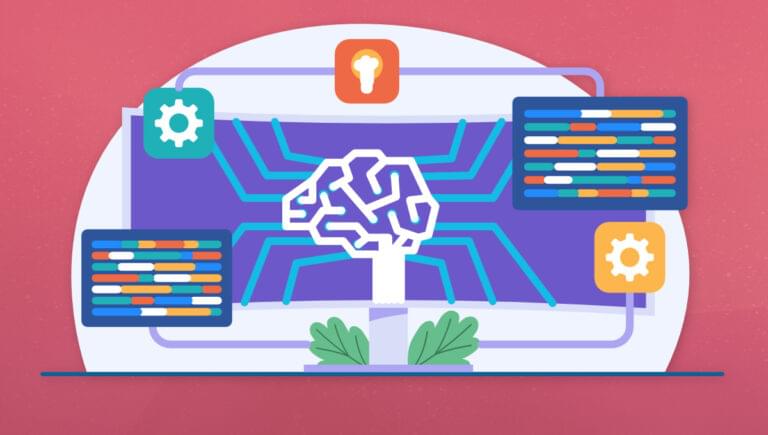In this tutorial, we’ll explore how to use GPT-4 to generate articles, reports, and social media posts more efficiently and effectively.
Content creation can be a lengthy and time-consuming process, especially for a web developer who isn’t a professional content writer. Writing a high-quality blog post, social media post or product description requires knowledge, skills, and creativity that are often beyond a web developer’s area of expertise. This is where GPT-4 comes in, allowing us to harness its power for content creation and writing assistance.
What is GPT-4?
GPT-4 is an artificial intelligence language model created by OpenAI, designed to understand and generate natural language text. It uses deep neural networks to learn patterns in large amounts of text data to generate new content. GPT-4 was released in March 2023, with even more advanced language processing capabilities than its predecessor, GPT-3. With GPT-4, we can generate high-quality content, summaries and much more in a matter of seconds.
Benefits of Using GPT-4 for Content Creation
Using GPT-4 for content creation has several benefits, including that it:
- saves time and energy spent on content writing
- produces high-quality content
- provides content ideas and outlines
- improves content SEO through relevant keyword utilization
- assists non-native speakers in writing content that reads naturally and is fluent in the English language
Using GPT-4 for Content Creation
There are several ways that we can use GPT-4 for content creation. Below are eight examples that will help us understand how we can start using GPT-4 for content creation now.
1. Creating product descriptions for ecommerce websites
Product descriptions are an essential part of ecommerce websites, as they help customers make informed decisions about purchasing products. However, writing engaging and informative product descriptions can be a challenge for web developers who aren’t accustomed to writing them. With GPT-4, we can generate product descriptions that accurately represent the product while captivating the customer.
Here’s a Python example for generating product descriptions with GPT-4:
# import OpenAI API
import openai
# set up API key
openai.api_key = "your_api_key"
# create a function to generate product descriptions
def generate_product_description(product_name):
prompt = f"Generate a product description for a {product_name}."
response = openai.Completion.create(
engine="text-davinci-002",
prompt=prompt,
temperature=0.5,
max_tokens=1024,
top_p=1,
frequency_penalty=0,
presence_penalty=0
)
description = response.choices[0].text
return description
# generate a product description for a headphones product
product_description = generate_product_description("headphones")
print(product_description)
The example above showcases a Python function for generating a product description for a given product name. The function uses the OpenAI API to interact with the text-davinci-002 GPT-4 engine. The prompt is a brief instruction telling the engine what we expect it to do, and our function uses it to request a product description. Once we provide the product name, GPT-4 will generate a unique product description for our product.
2. Writing blog posts for personal or business websites
Blogging is an excellent way to increase website traffic and engage with our audience. However, creating new and exciting content can be time-consuming and stressful. GPT-4 can be utilized to produce quality blog posts in a matter of minutes, allowing us to focus on other things. Using the Python code below, we can generate blog posts that are informative and cater to specific keywords to improve SEO performance:
# import open ai API
import openai
# Setting up API key
openai.api_key = "your_api_key"
# Create function for generating content
def generate_content(prompt):
response = openai.Completion.create(
engine="text-davinci-002",
prompt=prompt,
max_tokens=1024,
n=1,
stop=None,
temperature=0.5,
)
message = response.choices[0].text
return message
# Example blog prompt
prompt = """
Generate a blog article on how to improve your SEO rankings in 2021.
"""
blog_article = generate_content(prompt)
print(blog_article)
The example above shows a Python function for creating blog articles. The generate_content() function utilizes the OpenAI API to send a prompt to the GPT-4 engine — requesting it to complete the prompt with a high-quality article. We can use this if our business is looking for quick, high-quality content to feature on our website or if we’re a blogger who wants to publish more posts without producing it all ourself.
3. Generating social media posts for different platforms
Social media is an important part of online marketing, and can often require extensive creativity to stay engaging and relevant. GPT-4 can assist in creating unique and engaging social media captions that can improve the audience reach on different platforms such as Facebook, Instagram, Twitter, and LinkedIn.
Below is an example of how to use the OpenAI API to generate social media posts:
# import openai API
import openai
# Setting up API key
openai.api_key = "your_api_key"
# Create function for social media post generation
def generate_social_post(prompt):
response = openai.Completion.create(
engine="text-davinci-002",
prompt=prompt,
max_tokens=128,
n=1,
stop=None,
temperature=0.5,
)
message = response.choices[0].text
return message
# Facebook example prompt
prompt_facebook = "Generate a social media caption for Facebook promoting a new wine collection"
# Instagram example prompt
prompt_instagram = "Generate a social media caption for Instagram promoting a new wine collection"
# Generate Facebook and Instagram captions
facebook_caption = generate_social_post(prompt_facebook)
instagram_caption = generate_social_post(prompt_instagram)
print(f"Facebook Caption: {facebook_caption}")
print(f"Instagram Caption: {instagram_caption}")
This example demonstrates a Python function for generating social media captions for different platforms. GPT-4 can create social media captions that will resonate with our audience and entice them to continue engaging with our content.
4. Automatically summarizing long articles or academic papers
Summarizing long articles or academic papers can be a challenging task, especially when we’re short on time. With GPT-4, we can produce accurate and concise summaries of long pieces of content, allowing us to digest the core ideas or concepts in no time, rather than spending hours reading through an article or paper.
Here’s an example of how to utilize the OpenAI API to automatically summarize an article or an academic paper:
# Import libraries
import openai
import nltk
nltk.download('punkt')
from nltk.tokenize import sent_tokenize
# Setting up OpenAI API key
openai.api_key = "your_api_key"
# Define function for generating a summary
def generate_summary(text):
prompt = "Please summarize the following article:" + "\n" + text
# Request to OpenAI API
response = openai.Completion.create(
engine="text-davinci-002",
prompt=prompt,
max_tokens=1024,
n=1,
stop=None,
temperature=0.7,
)
summary = response.choices[0].text
return summary
# example text to summarize
article_text = "The quick brown fox jumps over the lazy dog. \
Lorem ipsum dolor sit amet, consectetur adipiscing elit, sed do eiusmod tempor incididunt ut labore \
et dolore magna aliqua. Ut enim ad minim veniam, quis nostrud exercitation ullamco laboris nisi ut \
aliquip ex ea commodo consequat."
summary_text = generate_summary(article_text)
print(summary_text)
The example above showcases a Python function that summarizes large pieces of content. The generate_summary() function uses the OpenAI text-davinci-002 GPT-4 engine. Once we provide the article’s text, GPT-4 will summarize the article in a clear and concise manner, allowing us to easily capture the main ideas and concepts of the content presented.
5. Generating news articles for media outlets or news agencies
Generating news articles efficiently is essential for media outlets and news agencies. However, it can be challenging to write high-quality articles that read well, inform readers and captivate their attention. With GPT-4, we can quickly generate news articles and distribute them across various media outlets.
The following example demonstrates how to utilize the OpenAI API to generate news articles:
# import openai API
import openai
# Setting up API key
openai.api_key = "your_api_key"
# Create function to generate news articles
def generate_news_article(prompt):
response = openai.Completion.create(
engine="text-davinci-002",
prompt=prompt,
max_tokens=1024,
n=1,
stop=None,
temperature=0.5,
)
message = response.choices[0].text
return message
# Example prompt
prompt = "Generate a news article on the recent acquisition of Company X by Company Y."
news_article = generate_news_article(prompt)
print(news_article)
The example above showcases a Python function that generates news articles based on a given prompt. With the OpenAI API, GPT-4 can produce high-quality and relevant news articles in a matter of seconds. Media outlets and news agencies can use GPT-4 to produce articles efficiently without sacrificing quality.
6. Writing content for email marketing campaigns
Creating email content for marketing campaigns can be time-consuming and often difficult to make engaging for readers. GPT-4 can assist in generating high-quality and engaging content for marketing emails.
Below is an example of using Python to generate email content:
# import OpenAI API
import openai
# Setting up API key
openai.api_key = "your_api_key"
# Create function for generating email content
def generate_email_content(prompt):
response = openai.Completion.create(
engine="text-davinci-002",
prompt=prompt,
max_tokens=1024,
n=1,
stop=None,
temperature=0.5,
)
message = response.choices[0].text
return message
# Example prompt
prompt = "Generate a message for a promotional email advertising a new car model."
email_content = generate_email_content(prompt)
print(email_content)
The example above demonstrates a Python function for generating content for email marketing campaigns using GPT-4. With this code, we can create promotional emails that are engaging and informative to the reader.
7. Providing writing assistance for non-native speakers of English
Non-native English speakers may require additional assistance in writing content that’s fluent and understandable. GPT-4 can help generate natural text and aid non-native speakers in improving their language writing skills.
Here’s an example of how to generate natural text that a non-native speaker of English can use:
# import OpenAI API
import openai
# Setting up API key
openai.api_key = "your_api_key"
# Create a function that can help non-native speakers in writing fluent, English sentences
def generate_natural_text(prompt):
response = openai.Completion.create(
engine="text-davinci-002",
prompt=prompt,
max_tokens=1024,
n=1,
stop=None,
temperature=0.7,
)
message = response.choices[0].text
return message
# example prompt
prompt = """
Assist users in writing natural English sentences by generating examples.
"""
natural_text_example = generate_natural_text(prompt)
print(natural_text_example)
The example above serves as a Python function used to provide writing assistance for non-native speakers of English. The users can send the content to the GPT-4 engine, and it will provide natural English text that a non-native speaker can use for their content.
8. Generating scripts for video content such as podcasts or YouTube videos
Creating scripts for video content such as podcasts or YouTube videos is a lengthy task that can take hours. With GPT-4, generating scripts can be done quickly, allowing the production process to be more efficient.
Here’s an example of how to utilize GPT-4 to generate scripts:
# import OpenAI API
import openai
# Setting up API key
openai.api_key = "your_api_key"
# Create function for generating scripts
def generate_script(prompt):
response = openai.Completion.create(
engine="text-davinci-002",
prompt=prompt,
max_tokens=1024,
n=1,
stop=None,
temperature=0.5,
)
message = response.choices[0].text
return message
# Example prompt
prompt = "Generate a script for a new episode of the social media podcast."
podcast_script = generate_script(prompt)
print(podcast_script)
The example above demonstrates a Python function that can be used to generate scripts for podcast or YouTube videos. With GPT-4’s ability to generate high-quality and engaging content, we can easily create scripts for video content, making the production process more efficient.
Conclusion
GPT-4 is a powerful tool for web developers who want to improve their content writing or generate high-quality content. With the OpenAI API, we can create unique and engaging product descriptions, blog posts, social media posts, academic paper summaries, news articles, email content, and generate scripts for video content.
Start incorporating GPT-4 into your content creation process today and leverage its capabilities to save time and produce excellent quality content.
Frequently Asked Questions (FAQs) about GPT-4 for Content Creation
What Makes GPT-4 Different from Its Predecessors?
GPT-4 is a significant upgrade from its predecessors in terms of size and capabilities. It has a larger model size, which means it can process and understand more complex language patterns. This makes it more efficient in generating human-like text, making it a powerful tool for content creation. It can generate articles, write essays, create poetry, and even draft emails. Its advanced AI capabilities allow it to understand context better, resulting in more coherent and relevant content.
How Can I Access GPT-4 for Content Creation?
Accessing GPT-4 for content creation is quite straightforward. You can access it through OpenAI’s API. You need to sign up for an API key, and once you have it, you can start using GPT-4. There are also several third-party applications and platforms that integrate GPT-4, allowing you to use it for various content creation tasks.
Is GPT-4 Reliable for Content Creation?
Yes, GPT-4 is a reliable tool for content creation. It’s designed to understand and mimic human language patterns, making it capable of generating high-quality, human-like content. However, like any AI tool, it’s not perfect and may require some human intervention for editing and fine-tuning.
Can GPT-4 Write in Different Styles and Tones?
Absolutely. GPT-4 can adapt to different writing styles and tones based on the input it receives. This makes it a versatile tool for content creation, capable of writing in a formal tone for business communications or a casual tone for blog posts.
How Does GPT-4 Handle Context in Content Creation?
GPT-4 has an advanced understanding of context compared to its predecessors. It can maintain the context of a conversation or a piece of content over a longer span, resulting in more coherent and relevant content.
Can GPT-4 Generate Content in Different Languages?
Yes, GPT-4 can generate content in multiple languages. It’s trained on a diverse range of internet text, so it can understand and generate content in various languages, making it a useful tool for global content creation.
Is GPT-4 Suitable for SEO Content Creation?
GPT-4 can be a useful tool for SEO content creation. It can generate keyword-rich content based on the input it receives. However, it’s important to remember that while GPT-4 can help with content creation, SEO also involves other factors like keyword research, link building, and website optimization.
How Can I Improve the Quality of Content Generated by GPT-4?
While GPT-4 is capable of generating high-quality content, you can improve the output by providing clear and detailed prompts. The more specific your input, the better the output will be. It’s also recommended to review and edit the content generated by GPT-4 to ensure it meets your requirements.
Can GPT-4 Replace Human Writers?
While GPT-4 is a powerful tool for content creation, it’s not likely to replace human writers. It can assist in generating drafts and ideas, but human intervention is still needed for editing, fine-tuning, and ensuring the content meets specific requirements and standards.
What Are the Limitations of Using GPT-4 for Content Creation?
While GPT-4 is advanced, it has its limitations. It can sometimes generate content that’s irrelevant or off-topic, especially with vague prompts. It also lacks the ability to fact-check or understand the world beyond the data it was trained on. Therefore, it’s important to review and edit the content generated by GPT-4.
 Mark Harbottle
Mark HarbottleMark Harbottle is the co-founder of SitePoint, 99designs, and Flippa.






